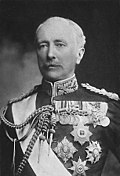| Field Marshal | |
|---|---|
 Shoulder strap for a field marshal | |
 | |
| Country | United Kingdom |
| Service branch | British Army |
| Abbreviation | FM |
| Rank | Five-star rank |
| NATO rank code | OF-10 |
| Formation | 1736 |
| Next lower rank | General |
| Equivalent ranks | Admiral of the Fleet (RN) Marshal of the Royal Air Force (RAF) |
Field marshal (FM) has been the highest rank in the British Army since 1736. A five-star rank with NATO code OF-10, it is equivalent to an Admiral of the Fleet in the Royal Navy or a Marshal of the Royal Air Force in the Royal Air Force (RAF). A Field Marshal's insignia consists of two crossed batons surrounded by yellow leaves below the Tudor Crown. Like Marshals of the Royal Air Force and Admirals of the Fleet, Field Marshals traditionally remain officers for life, though on half-pay when not in an appointment or retired. [1] [2] The rank has been used sporadically throughout its history, and was vacant during parts of the 18th and 19th centuries (when all former holders of the rank were deceased). After the Second World War, it became standard practice to appoint the Chief of the Imperial General Staff (later renamed Chief of the General Staff) to the rank on his last day in the post. Army officers occupying the post of Chief of the Defence Staff, the professional head of all the British Armed Forces, were usually promoted to the rank upon their appointment. [3]
Contents
In total, 143 men have held the rank of field marshal. The majority led careers in the British Army or the colonial British Indian Army, rising through the ranks to eventually become a field marshal. Some members of the British royal family, most recently Prince Edward, Duke of Kent and Charles III, were promoted to the rank after shorter periods of service. Three British monarchs (George V, Edward VIII, and George VI) assumed the rank on their accessions to the throne, while Edward VII and Charles III were already field marshals, and two British consorts, Albert, Prince Consort and Prince Philip, Duke of Edinburgh, were appointed by their respective queens. Other ceremonial appointments were made as diplomatic gestures. Twelve foreign monarchs have held the honour, though three (Wilhelm II, German Emperor; Franz Joseph I, Emperor of Austria-Hungary; and Hirohito, Emperor of Japan) were stripped of it when their countries became enemies of Britain and its allies in the two world wars. Also awarded the rank were one Frenchman (Ferdinand Foch) and one Australian (Sir Thomas Blamey), honoured for their contributions in World War I and World War II respectively, and one South African statesman (Jan Smuts). [4]
A report commissioned by the Ministry of Defence in 1995 made a number of recommendations for financial savings in the armed forces' budget, one of which was the abolition of all five-star ranks. Part of the rationale was that these ranks were disproportionate to the size of the forces commanded by these officers, and that none of the United Kingdom's close allies, such as the United States (which reserves the rank of general of the army for officers who have commanded large armies in major wars), used such ranks. The recommendation was not taken up in full, but the practice of promoting service chiefs to five-star ranks was stopped, and the ranks are now reserved for special circumstances. Sir Peter Inge was, in 1994, the last active officer to be promoted to the rank. Inge relinquished the post of Chief of the Defence Staff (CDS) in 1997, and his successor, Sir Charles Guthrie, was the first officer not to be promoted upon appointment as CDS, although he was promoted to the honorary rank of field marshal in June 2012. [5]
More promotions to field marshal came in 2012, eighteen years after the moratorium on routine promotions to the rank, when Queen Elizabeth II promoted Prince Charles, her son and heir, to the five-star ranks in all three services, in recognition of support provided for her in her capacity as Head of the British Armed Forces. [6] At the same time, Guthrie, who relinquished the post of CDS and retired from active service in 2001, was promoted to honorary field marshal. [7] In June 2014, former Chief of the Defence Staff Lord Walker of Aldringham was also promoted to honorary field marshal. [8] The most recent promotions to the rank came in June 2025, when former Chiefs of the Defence Staff Lord Richards of Herstmonceux and Lord Houghton of Richmond were also promoted to the rank. [9]
Although the rank of field marshal is not used in the Royal Marines, the insignia is used on the uniform of the Captain General, the ceremonial head of the corps (equivalent to colonel-in-chief). [10]





































































































































